 Up
Up
|
|

|

|
Bloch’s Gewichtschnellrechner |
|
|
|
|
This unusual device is the System Bloch Gewichtschnellrechner, or rapid weight calculator. Invented by Georg Bloch of Böblingen, Germany, around 1920, it allows calculation of the weight of right prisms and cylinders made of a given material (a right prism is a geometric solid that has identical polygons as its base and top, and vertical sides perpendicular to the base). |
|
|
|
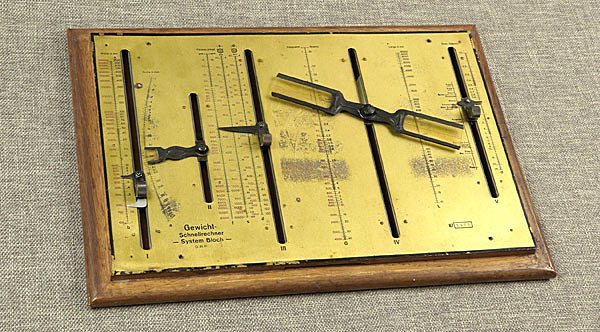 Click photo to enlarge |
|
|
|
The math behind the calculation is simple
enough: Weight = (Width x Thickness) x Length x Specific gravity
[For rectangular objects] The calculator has four controls: three
knobbed sliders and one hinged cursor (the one with two celluloid
“wings”). These are used to feed in the input parameters of the
calculation: the dimensions of the piece and the material composing
it. The computed result is read under the hairline of the left
“wing” of the large cursor. The small cursor on the curved scale
indicates the thickness parameter entered by moving the middle knob.
The device is 38x26.5 cm in size. |
|
|
|
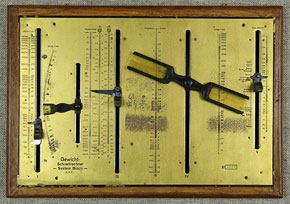
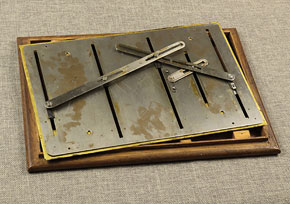 Click a photo to enlarge |
|
|
|
The two cursors are each moved when you move
either of the two knobs to their sides; you can play with this in a
lovely interactive simulation
found here. How
this is done is clear from the photo of the back side of the device,
where the different sliders are interconnected by an ingenious
mechanism of interlinked sliding rods. Essentially this is a
mechanical implementation of a
nomogram (a
concept also used in
Kaufmann’s
posographe). The Bloch device actually does two calculations –
it calculates the base area on its left half and then multiplies this
by the height and the specific gravity on the right, using the linked
rods to feed the results of one calculation as the input to the
other. Pretty neat! The calculator works good as new, but it doesn’t look new: Its surface is marred by corrosion. This is actually what motivated me to buy it in the first place. Usually I’d steer clear of such disfigurement, but here I saw a magnificent demonstration of the damage wrought by a phenomenon known as “celluloid rot”. It is obvious that the two prominent corroded rectangles on the calculator were “imprinted” by the two celluloid cursors when these were stored over them for some long duration; slighter imprints mark other positions held for shorter periods. In addition, the small cursor at the left has corroded a spot at the bottom of the curved scale. And this unit is by no means unusual: other exemplars of the same calculator can be seen online with even worse corrosion of the same nature. |
|
|
|
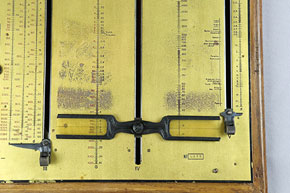
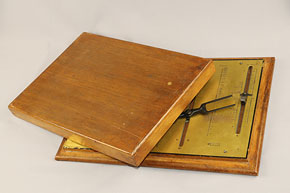 Click a photo to enlarge |
|
|
|
So what is going on here? Celluloid, the first plastic material, is a form of cellulose nitrate, a highly flammable material used to produce explosives. Over time it can undergo a chemical deterioration that can discolor, warp, and ultimately disintegrate it completely (this last is the bane of old film reel archives!). The process creates corrosives like nitric acid and nitrogen dioxide gas that can destroy other nearby materials, notably metals. The damage is worst when there is no ventilation – and the Bloch Schnellrechner comes with a very close-fitting wooden lid! Of course, as soon as it arrived I hung it on my wall without the lid, affording it ample airflow, and I see no more damage. |
|
|
|
Exhibit provenance: I bought this one online from an antiques shop in Vienna. More info: Interactive
simulation. |
|
|
|
|
|
|
|
Home | HOC | Fractals | Miscellany | About | Contact Copyright © 2022 N. Zeldes. All rights reserved. |
|